Assessing the Economic Performance and Environmental Impact of Farming Systems Based on Different Organic Conservation Practices in Processing Tomato Cultivation
Abstract
1. Introduction
2. Materials and Methods
2.1. Experimental Layout
2.2. Agriculture Operations Performed and Machines Employed Within the Technical Itineraries
2.3. Technical Itineraries Operative and Economic Performance Estimation
2.4. Statistical Analysis
3. Results
3.1. Economic Performances of the First Year
3.2. Economic Performances of the Second Year
3.3. Technical Itineraries’ CO2 Emissions
4. Discussion
5. Conclusions
Author Contributions
Funding
Data Availability Statement
Acknowledgments
Conflicts of Interest
References
- El Bilali, H. Transition Heuristic Frameworks in Research on Agro-Food Sustainability Transitions. Environ. Dev. Sustain. 2020, 22, 1693–1728. [Google Scholar] [CrossRef]
- Liu, X.; Chen, Y.; Liu, Y.; Wang, S.; Jin, J.; Zhao, Y.; Yu, D. A Framework Combining CENTURY Modeling and Chronosequences Sampling to Estimate Soil Organic Carbon Stock in an Agricultural Region with Large Land Use Change. Agronomy 2023, 13, 1055. [Google Scholar] [CrossRef]
- IPCC Longer Report. In Climate Change 2023: Synthesis Report; IPCC: Geneva, Switzerland, 2023.
- Wang, X.; Zheng, Z.; Jia, W.; Tai, K.; Xu, Y.; He, Y. Response Mechanism and Evolution Trend of Carbon Effect in the Farmland Ecosystem of the Middle and Lower Reaches of the Yangtze River. Agronomy 2024, 14, 2354. [Google Scholar] [CrossRef]
- Peigné, J.; Ball, B.C.; Roger-Estrade, J.; David, C. Is Conservation Tillage Suitable for Organic Farming? A Review. Soil Use Manag. 2007, 23, 129–144. [Google Scholar] [CrossRef]
- Morris, D.R.; Gilbert, R.A.; Reicosky, D.C.; Gesch, R.W. Oxidation Potentials of Soil Organic Matter in Histosols under Different Tillage Methods. Soil Sci. Soc. Am. J. 2004, 68, 817–826. [Google Scholar] [CrossRef]
- Sapkota, T.B.; Mazzoncini, M.; Bàrberi, P.; Antichi, D.; Silvestri, N. Fifteen Years of No till Increase Soil Organic Matter, Microbial Biomass and Arthropod Diversity in Cover Crop-Based Arable Cropping Systems. Agron. Sustain. Dev. 2012, 32, 853–863. [Google Scholar] [CrossRef]
- Holland, J.M. The Environmental Consequences of Adopting Conservation Tillage in Europe: Reviewing the Evidence. Agric. Ecosyst. Environ. 2004, 103, 1–25. [Google Scholar] [CrossRef]
- Akbarnia, A.; Farhani, F. Study of Fuel Consumption in Three Tillage Methods. Res. Agric. Eng. 2014, 60, 142–147. [Google Scholar] [CrossRef]
- Diacono, M.; Ciaccia, C.; Canali, S.; Fiore, A.; Montemurro, F. Assessment of Agro-Ecological Service Crop Managements Combined with Organic Fertilisation Strategies in Organic Melon Crop. Ital. J. Agron. 2018, 13, 172–182. [Google Scholar] [CrossRef]
- USDA Cover Crops for Climate Resilience. Available online: https://www.climatehubs.usda.gov/hubs/international/topic/cover-crops-climate-resilience#:~:text=Cover%20crops%20can%3A,and%20mitigate%20some%20greenhouse%20gases (accessed on 10 October 2024).
- Martin, G.A.; Sahoo, C. Cover Crops and Green Manure Crops. In Sustainable Crop; Panotra, N., Salgotra, R.K., Sharma, M., Gupta, V., Eds.; ND Global Publication: Delhi, India, 2024. [Google Scholar]
- Riemens, M.; Sønderskov, M.; Moonen, A.-C.; Storkey, J.; Kudsk, P. An Integrated Weed Management Framework: A Pan-European Perspective. Eur. J. Agron. 2022, 133, 126443. [Google Scholar] [CrossRef]
- Kornecki, T.S.; Kichler, C.M. Effectiveness of Cover Crop Termination Methods on No-Till Cantaloupe. Agriculture 2022, 12, 66. [Google Scholar] [CrossRef]
- Frasconi, C.; Martelloni, L.; Antichi, D.; Raffaelli, M.; Fontanelli, M.; Peruzzi, A.; Benincasa, P.; Tosti, G. Combining Roller Crimpers and Flaming for the Termination of Cover Crops in Herbicide-Free No-till Cropping Systems. PLoS ONE 2019, 14, e0211573. [Google Scholar] [CrossRef]
- Delate, K.; Cwach, D.; Chase, C. Organic No-Tillage System Effects on Soybean, Corn and Irrigated Tomato Production and Economic Performance in Iowa, USA. Renew. Agric. Food Syst. 2012, 27, 49–59. [Google Scholar] [CrossRef]
- Pearsons, K.A.; Chase, C.; Omondi, E.C.; Zinati, G.; Smith, A.; Rui, Y. Reducing Tillage Does Not Affect the Long-Term Profitability of Organic or Conventional Field Crop Systems. Front. Sustain. Food Syst. 2023, 6, 1004256. [Google Scholar] [CrossRef]
- O’Reilly, K.A.; Lauzon, J.D.; Vyn, R.J.; Van Eerd, L.L. Nitrogen Cycling, Profit Margins and Sweet Corn Yield under Fall Cover Crop Systems. Can. J. Soil. Sci. 2012, 92, 353–365. [Google Scholar] [CrossRef]
- Ding, G.; Liu, X.; Herbert, S.; Novak, J.; Amarasiriwardena, D.; Xing, B. Effect of Cover Crop Management on Soil Organic Matter. Geoderma 2006, 130, 229–239. [Google Scholar] [CrossRef]
- Severini, S.; Castellari, M.; Cavalli, D.; Pecetti, L. Economic Sustainability and Riskiness of Cover Crop Adoption for Organic Production of Corn and Soybean in Northern Italy. Agronomy 2021, 11, 766. [Google Scholar] [CrossRef]
- Belfry, K.D.; Trueman, C.; Vyn, R.J.; Loewen, S.A.; Van Eerd, L.L. Winter Cover Crops on Processing Tomato Yield, Quality, Pest Pressure, Nitrogen Availability, and Profit Margins. PLoS ONE 2017, 12, e0180500. [Google Scholar] [CrossRef]
- Abou Chehade, L.; Antichi, D.; Frasconi, C.; Sbrana, M.; Tramacere, L.G.; Mazzoncini, M.; Peruzzi, A. Legume Cover Crop Alleviates the Negative Impact of No-Till on Tomato Productivity in a Mediterranean Organic Cropping System. Agronomy 2023, 13, 2027. [Google Scholar] [CrossRef]
- Council Regulation (EC) No 834/2007 of 28 June 2007 on Organic Production and Labelling of Organic Products and Repealing Regulation (EEC) No 2092/91. Available online: https://eur-lex.europa.eu/legal-content/EN/TXT/HTML/?uri=CELEX:32007R0834 (accessed on 2 October 2024).
- Frasconi, C.; Martelloni, L.; Raffaelli, M.; Fontanelli, M.; Abou Chehade, L.; Peruzzi, A.; Antichi, D. A Field Vegetable Transplanter for Use in Both Tilled and No-Till Soils. Trans. ASABE 2019, 62, 593–602. [Google Scholar] [CrossRef]
- ISMEA ISMEA Mercati. Available online: https://www.ismeamercati.it/flex/cm/pages/ServeBLOB.php/L/IT/IDPagina/1881 (accessed on 11 September 2024).
- ENEA Potere Calorifico. Available online: https://www.efficienzaenergetica.enea.it/glossario-efficienza-energetica/lettera-p/potere-calorifico.html (accessed on 30 September 2024).
- European Commission COMMISSION DELEGATED REGULATION (EU) 2023/1185 of 10 February 2023. Supplementing Directive (EU) 2018/2001 of the European Parliament and of the Council by Establishing a Minimum Threshold for Greenhouse Gas Emissions Savings of Recycled Carbon Fuels and by Specifying a Methodology for Assessing Greenhouse Gas Emissions Savings from Renewable Liquid and Gaseous Transport Fuels of Non-Biological Origin and from Recycled Carbon Fuels. Off. J. Eur. Union 2023, L 157, 20–33.
- Gagliardi, L.; Sportelli, M.; Fontanelli, M.; Sbrana, M.; Luglio, S.M.; Raffaelli, M.; Peruzzi, A. Effects of Conservation Agriculture Practices on Tomato Yield and Economic Performance. Agronomy 2023, 13, 1704. [Google Scholar] [CrossRef]
- Hobbs, P.R. Conservation Agriculture: What Is It and Why Is It Important for Future Sustainable Food Production? J. Agric. Sci. 2007, 145, 127–137. [Google Scholar] [CrossRef]
- Sainju, U.M.; Singh, B.P.; Whitehead, W.F. Comparison of the Effects of Cover Crops and Nitrogen Fertilization on Tomato Yield, Root Growth, and Soil Properties. Sci. Hortic. 2001, 91, 201–214. [Google Scholar] [CrossRef]
- Dalbianco, A.B.; Santi, A.; Oliveira, R.C.D.; Borges, C.V.; Daniel, D.F.; Trento, D.A.; Dipple, F.L.; Dallacort, R.; Seabra Júnior, S. Can Soil Cover Affect the Performance, Yield, and Quality of Creeping Fresh Market Tomato Hybrids? Horticulturae 2023, 9, 574. [Google Scholar] [CrossRef]
- Muchanga, R.A.; Hirata, T.; Uchida, Y.; Hatano, R.; Araki, H. Soil Carbon and Nitrogen and Tomato Yield Response to Cover Crop Management. Agron. J. 2020, 112, 1636–1648. [Google Scholar] [CrossRef]
- Du, C.; Li, L.; Effah, Z. Effects of Straw Mulching and Reduced Tillage on Crop Production and Environment: A Review. Water 2022, 14, 2471. [Google Scholar] [CrossRef]
- Mallory, E.B.; Posner, J.L.; Baldock, J.O. Performance, Economics, and Adoption of Cover Crops in Wisconsin Cash Grain Rotations: On-Farm Trials. Am. J. Altern. Agric. 1998, 13, 2–11. [Google Scholar] [CrossRef]
- Clark, C.A. The Important Role of Soil Texture on Water; University of Wisconsin-Madison, Crops and Soils, Division of Extension: Madison, WI, USA, 2024. [Google Scholar]
- Wagner, K.; Cardon, G. Gardening in Sandy Soils. Utah State University. Yard and Garden Extension. 2015. Available online: https://digitalcommons.usu.edu/extension_curall/731/ (accessed on 30 September 2024).
- Igoni, A.H.; Ekemube, R.A.; Nkakini, S.O. Tractor Fuel Consumption Dependence on Speed and Height of Ridging on a Sandy Loam Soil. J. Eng. Technol. Res. 2020, 12, 47–54. [Google Scholar]
- Kim, W.-S.; Baek, S.-M.; Baek, S.-Y.; Jeon, H.-H.; Siddique, M.A.A.; Kim, T.-J.; Lim, R.-G.; Kim, Y.-J. Evaluation of Exhaust Emissions of Agricultural Tractors Using Portable Emissions Measurement System in Korean Paddy Field. Sci. Rep. 2024, 14, 3491. [Google Scholar] [CrossRef] [PubMed]
- Stošić, M.; Ivezić, V.; Tadić, V. Tillage Systems as a Function of Greenhouse Gas (GHG) Emission and Fuel Consumption Mitigation. Environ. Sci. Pollut. Res. 2021, 28, 16492–16503. [Google Scholar] [CrossRef] [PubMed]
- Melland, A.R.; Antille, D.L.; Dang, Y.P. Effects of Strategic Tillage on Short-Term Erosion, Nutrient Loss in Runoff and Greenhouse Gas Emissions. Soil Res. 2017, 55, 201. [Google Scholar] [CrossRef]
- Datta, A.; Knezevic, S.Z. Chapter Six—Flaming as an Alternative Weed Control Method for Conventional and Organic Agronomic Crop Production Systems: A Review. In Advances in Agronomy; Sparks, D.L., Ed.; Elsevier: Amsterdam, The Netherlands, 2013; Volume 118, pp. 399–428. [Google Scholar]
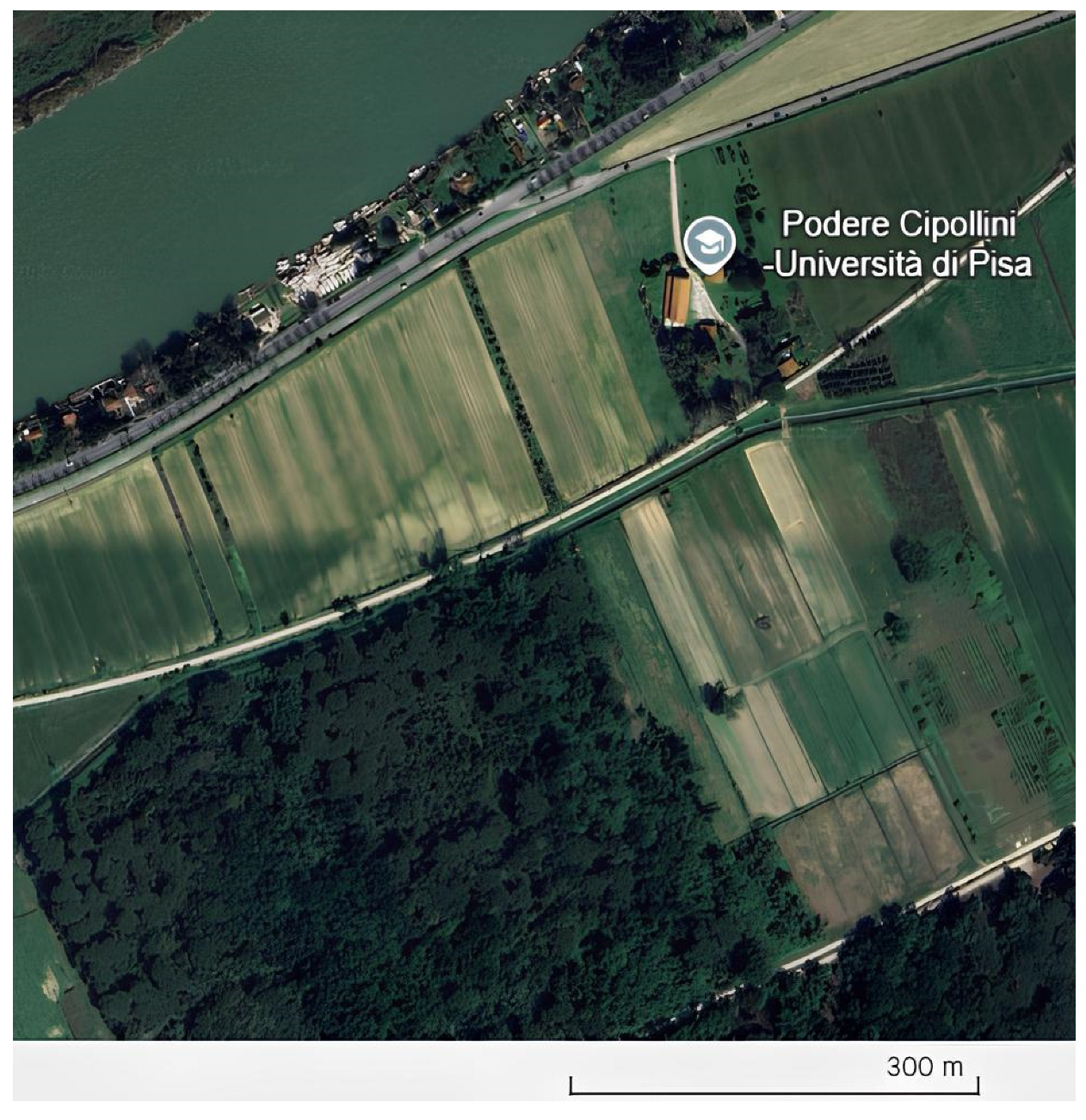
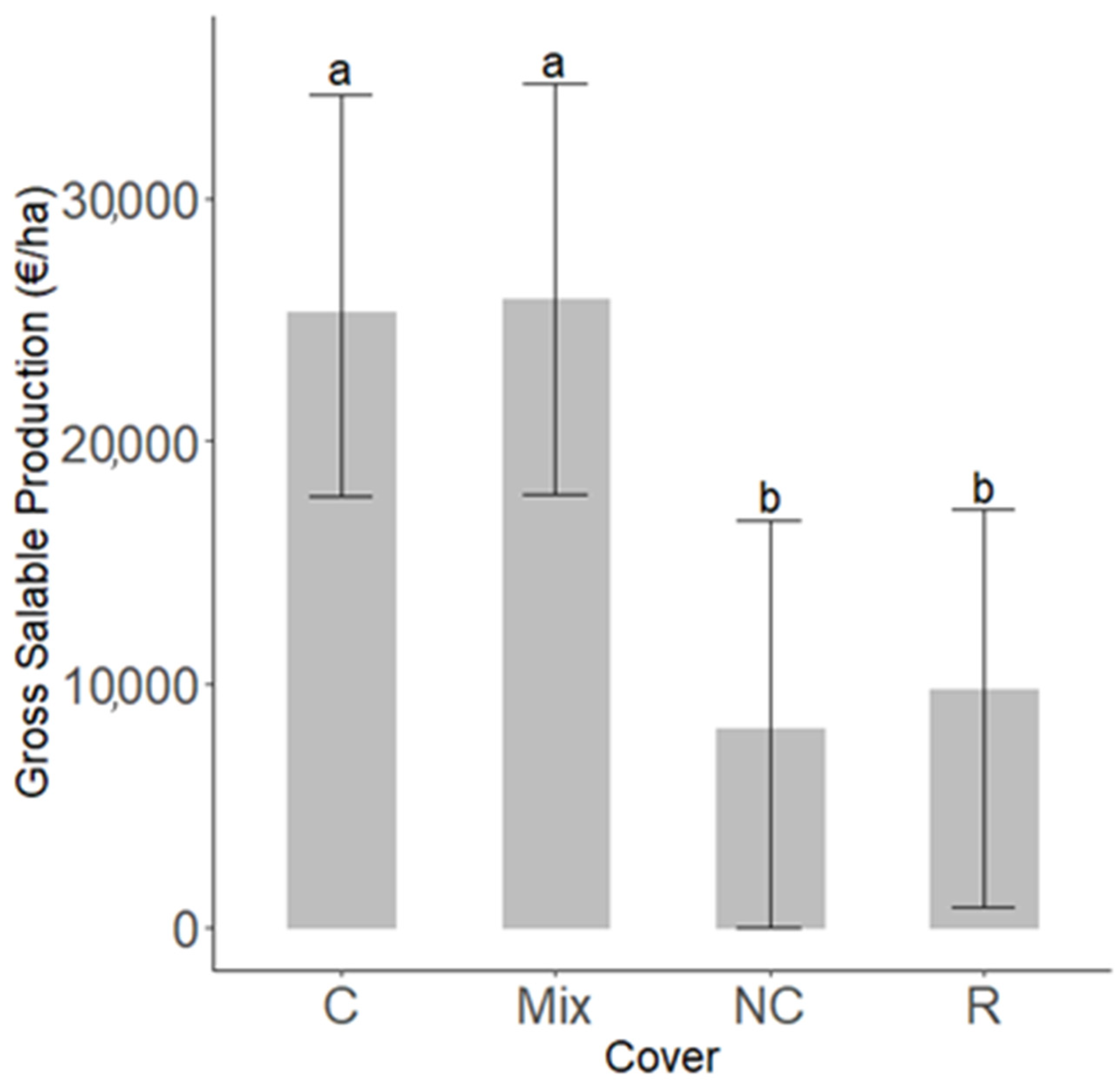
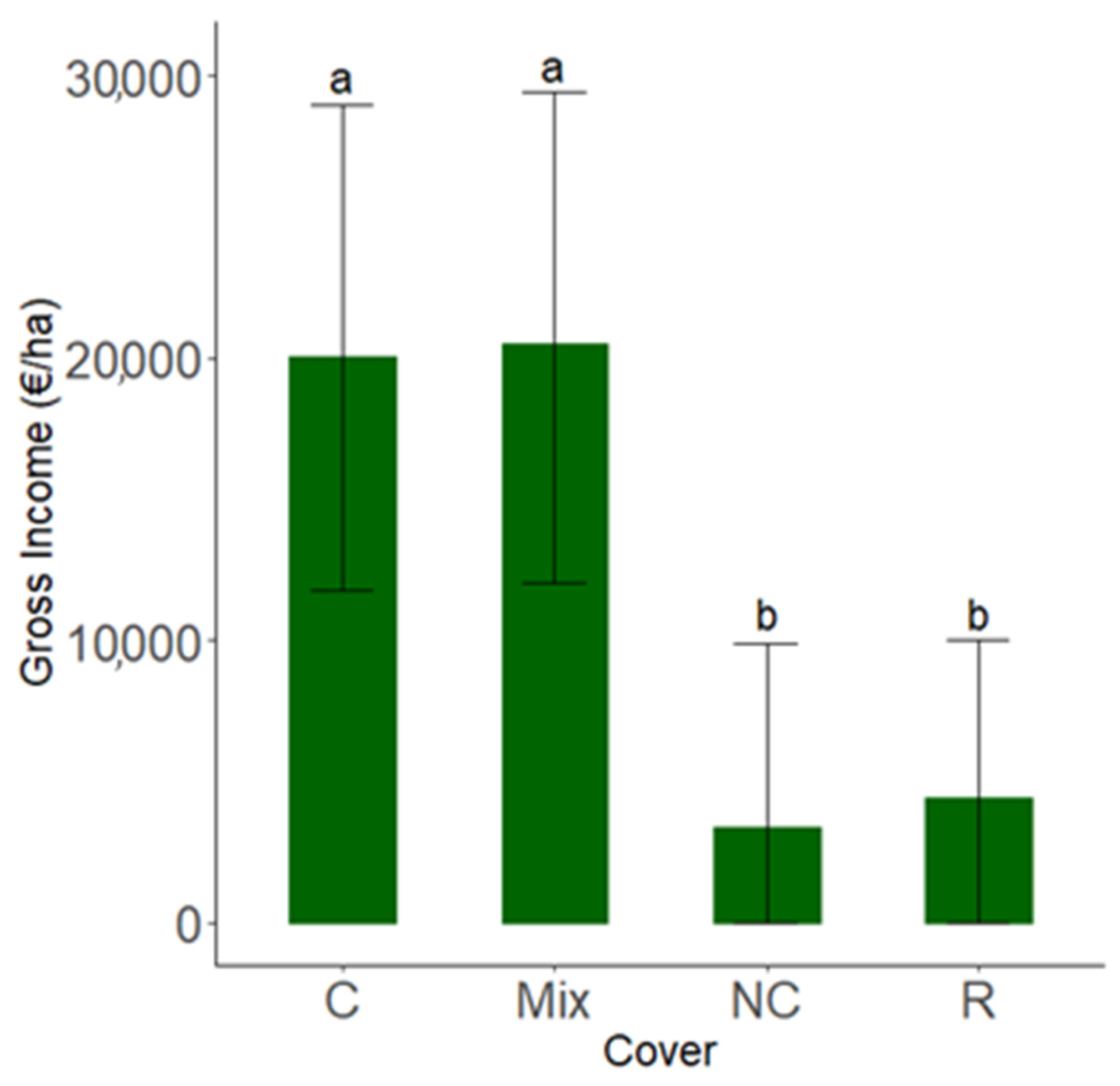
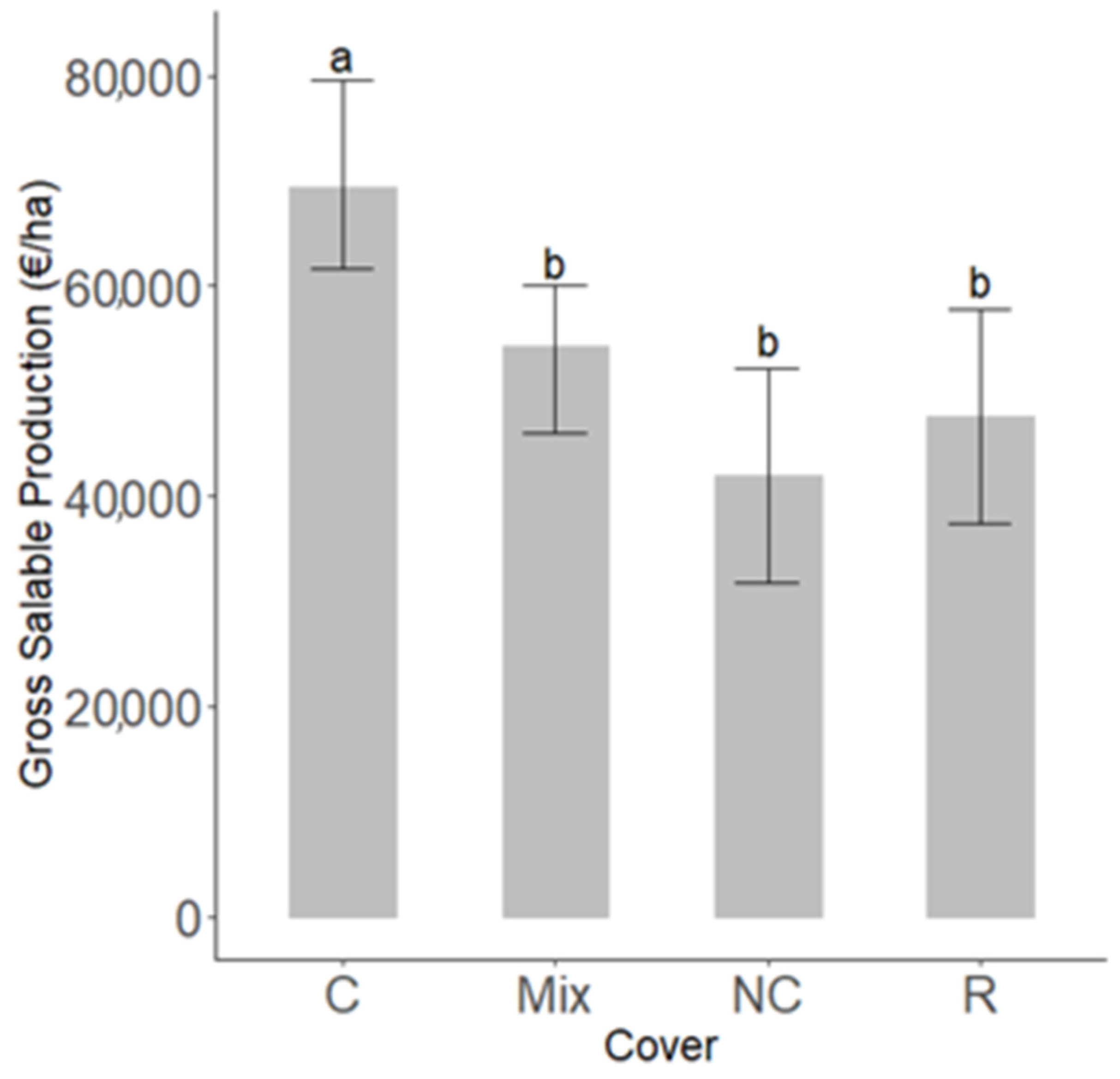
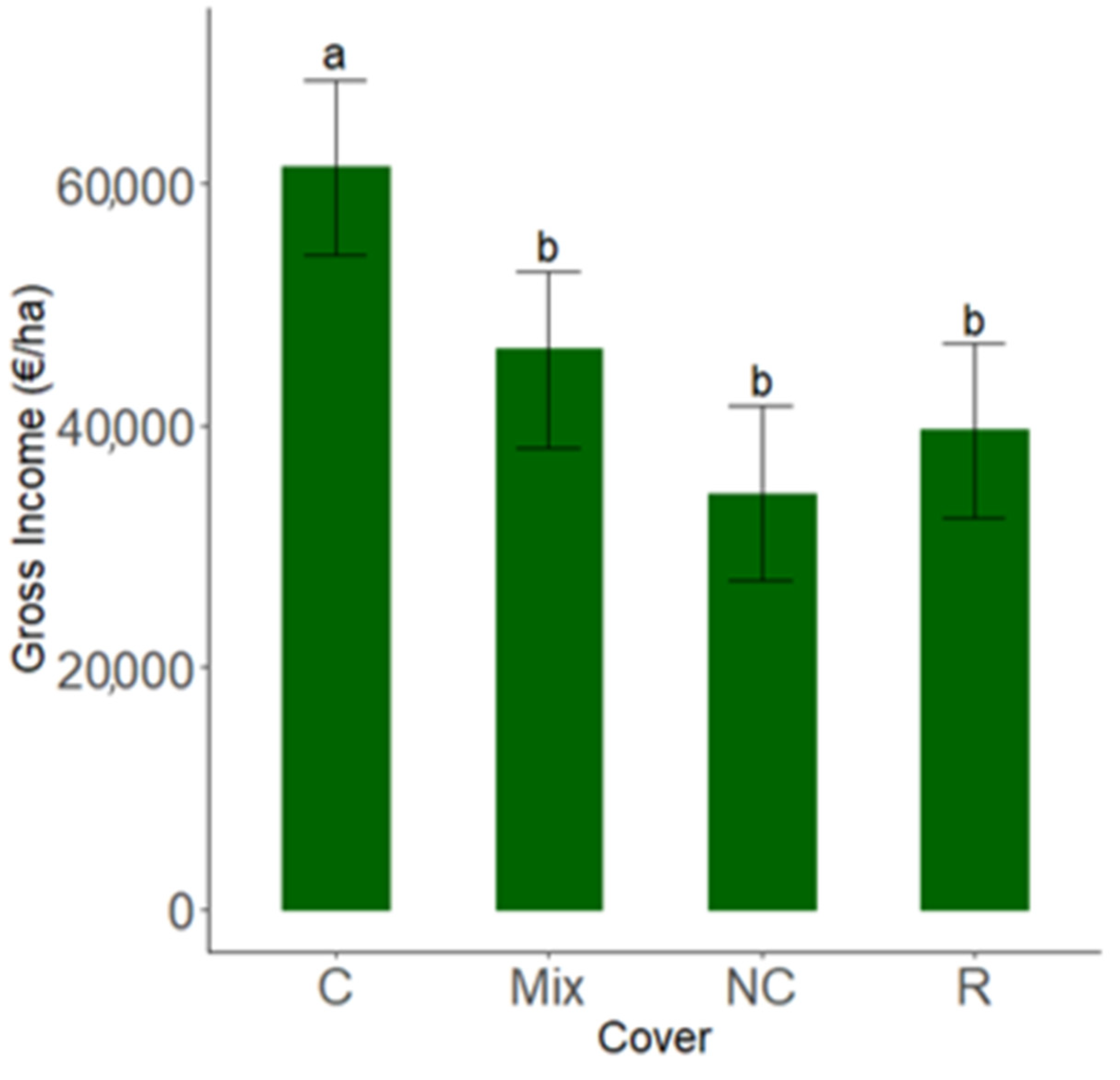
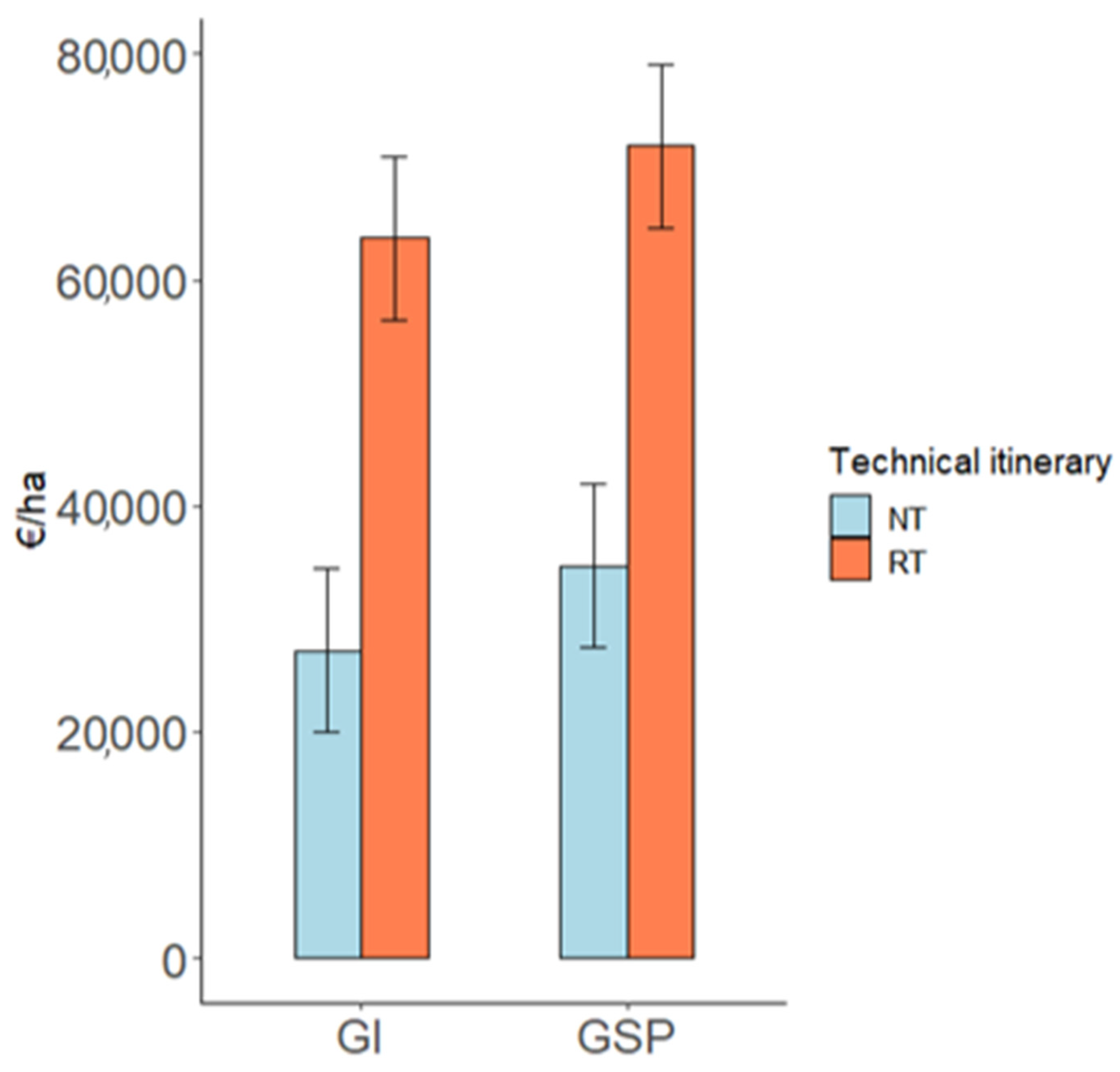
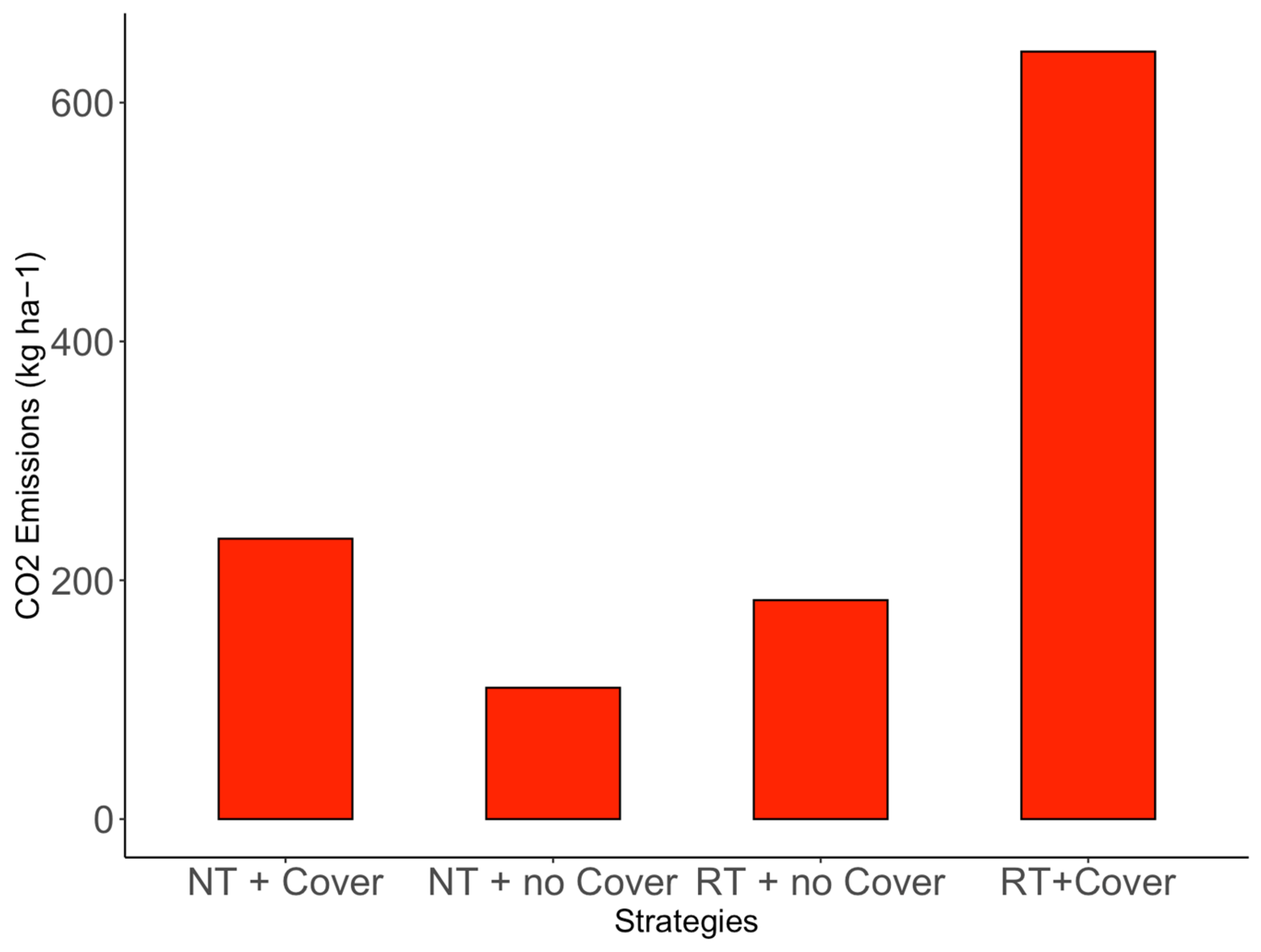
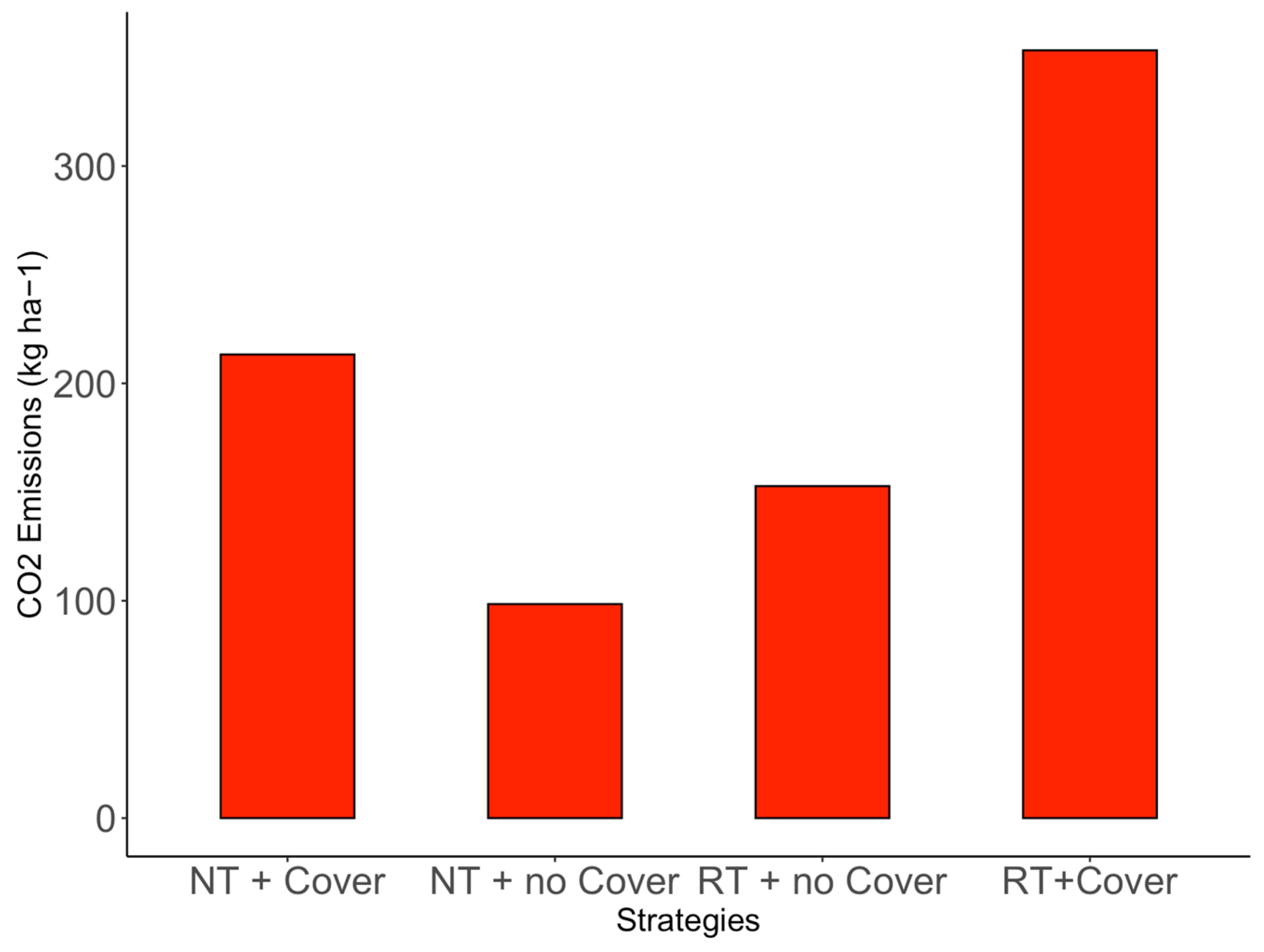
| Reduced-Tillage Management System (RT) | No-Till Management System (NT) | |
|---|---|---|
| Type of cover crop | Cover crop (Squarrose clover (RT-C); Rye (RT-R); Mixture (RT-Mix); No cover crop (RT-NC) 1 | Cover crop (Squarrose clover (NT-C); Rye (NT-R); Mixture (NT-Mix); No cover crop (NT-NC) 1 |
| Cover crop management | Green manure | Dead mulch |
| Transplant | Transplanting on tilled soil | Transplanting on dead mulch |
| Weed control | Precision hoeing | Shredding |
| Hand weeding | Hand weeding |
| Machines | Values (km/h) |
|---|---|
| Combined cultivator | 4.82–7.03 |
| Rotary harrow | 3.20–4.73 |
| Mulcher | 4.91–6.57 |
| Roller crimper | 5.61–8.18 |
| Flaming machine | 2.43–3.58 |
| Transplanter | 1.67–2.43 |
| Sprayer | 3.64–5.31 |
| Precision weeder | 2.81–4.16 |
| Fuel Consumption (kg/ha) | Field Time (h/ha) | Labor Cost (EUR/ha) | ||
|---|---|---|---|---|
| 2020 | RT + C | 202.75 | 146.31 | 2926.26 |
| 2020 | RT + noC | 39.20 | 92.79 | 1855.79 |
| 2020 | NT + C | 52.29 | 143.31 | 2866.25 |
| 2020 | NT + noC | 22.10 | 69.51 | 1390.14 |
| 2021 | RT+ C | 127.67 | 209.62 | 4434.94 |
| 2021 | RT + noC | 29.59 | 74.54 | 1490.75 |
| 2021 | NT + C | 107.16 | 217.93 | 4358.59 |
| 2021 | NT + noC | 31.06 | 69.38 | 1387.69 |
| Source | GSP | GI |
|---|---|---|
| Year | *** | *** |
| CC | *** | *** |
| TI | *** | *** |
| CC × Year | NS | NS |
| TI × Year | *** | *** |
| CC × TI | NS | NS |
| CC × TI × Year | NS | NS |
| Source | GSP | GI |
|---|---|---|
| CC | * | * |
| TI | NS | NS |
| CC × TI | NS | NS |
| Source | GSP | GI |
|---|---|---|
| CC | ** | ** |
| TI | *** | *** |
| CC × TI | NS | NS |
Disclaimer/Publisher’s Note: The statements, opinions and data contained in all publications are solely those of the individual author(s) and contributor(s) and not of MDPI and/or the editor(s). MDPI and/or the editor(s) disclaim responsibility for any injury to people or property resulting from any ideas, methods, instructions or products referred to in the content. |
© 2025 by the authors. Licensee MDPI, Basel, Switzerland. This article is an open access article distributed under the terms and conditions of the Creative Commons Attribution (CC BY) license (https://creativecommons.org/licenses/by/4.0/).
Share and Cite
Gagliardi, L.; Luglio, S.M.; Fontanelli, M.; Raffaelli, M.; Frasconi, C.; Fatchurrahman, D.; Peruzzi, A. Assessing the Economic Performance and Environmental Impact of Farming Systems Based on Different Organic Conservation Practices in Processing Tomato Cultivation. Appl. Sci. 2025, 15, 1883. https://doi.org/10.3390/app15041883
Gagliardi L, Luglio SM, Fontanelli M, Raffaelli M, Frasconi C, Fatchurrahman D, Peruzzi A. Assessing the Economic Performance and Environmental Impact of Farming Systems Based on Different Organic Conservation Practices in Processing Tomato Cultivation. Applied Sciences. 2025; 15(4):1883. https://doi.org/10.3390/app15041883
Chicago/Turabian StyleGagliardi, Lorenzo, Sofia Matilde Luglio, Marco Fontanelli, Michele Raffaelli, Christian Frasconi, Danial Fatchurrahman, and Andrea Peruzzi. 2025. "Assessing the Economic Performance and Environmental Impact of Farming Systems Based on Different Organic Conservation Practices in Processing Tomato Cultivation" Applied Sciences 15, no. 4: 1883. https://doi.org/10.3390/app15041883
APA StyleGagliardi, L., Luglio, S. M., Fontanelli, M., Raffaelli, M., Frasconi, C., Fatchurrahman, D., & Peruzzi, A. (2025). Assessing the Economic Performance and Environmental Impact of Farming Systems Based on Different Organic Conservation Practices in Processing Tomato Cultivation. Applied Sciences, 15(4), 1883. https://doi.org/10.3390/app15041883












